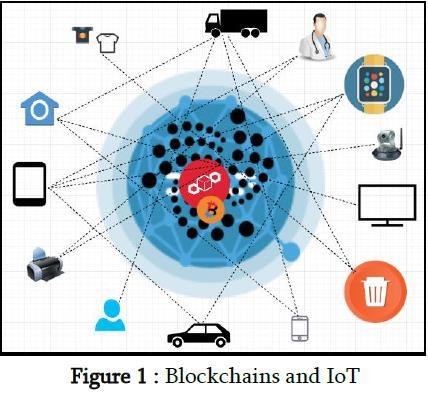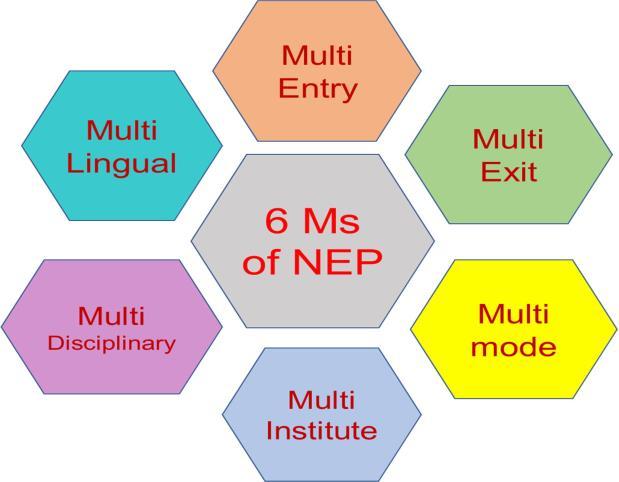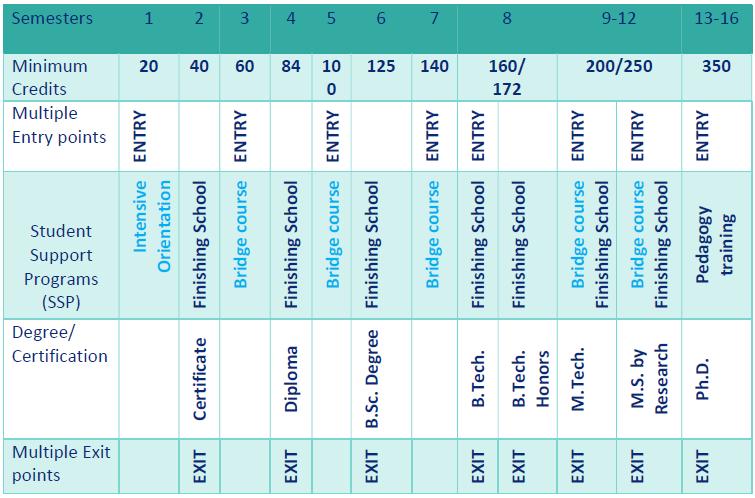

A Comprehensive Review of Integrating IoT and Blockchain Technologies in the Implementation of National Education Policy in education sector
Sahil Sawant1 , Prof. Ganesh .V. Manerkar2
1Student, Department of Information Technology and Engineering, Goa College of Engineering, Farmagudi, Goa, India
2Assistant Professor, Department of Information Technology and Engineering, Goa College of Engineering, Farmagudi, Goa, India
Abstract - This paper explores the synergistic application of Internet of Things (IoT) and blockchain technologies to bolster the successful implementation of National Education Policy (NEP) initiatives in the education sector. As education undergoes transformative changes, the integration of these technologies offers promising solutions to address challenges related to data security, transparency, and efficiency. The proposed framework includes leveraging blockchain for secure student data management, credential verification, and decentralized learning platforms. Concurrently, IoT devices are employed to create smart classrooms, automate attendance tracking, enable real-time monitoring, and enhance the overall learning experience. The use of blockchain ensures the integrity of examination processes and resource allocation, while smart contracts automate agreements among stakeholders. While highlighting the potential benefits, this paper alsoemphasizestheneedforcarefulconsiderationofchallengesand collaborative efforts among educational institutions, government bodies, and technology providers. The envisioned integration of IoT and blockchain technologies has the potential to revolutionize the education landscape, fostering a more secure, transparent, and efficient educational ecosystem aligned with the objectives of the National Education Policy.
Key Words: InternetofThings(IOT),Blockchain,National educationpolicy(NEP),Security,communication
1.INTRODUCTION
In the wake of the evolving landscape of education, the successful implementation of National Education Policy (NEP) mandates a proactive embrace of innovative technologies to address emerging challenges. This paper explorestheintegrationoftwotransformativetechnologies, theInternetofThings(IoT)andblockchain,toenhancethe realization of NEP objectives within the education sector. Theconvergenceofthesetechnologiesholdsthepromiseof fostering a more secure, transparent, and efficient educationalecosystem,aligningwiththeprinciplesandgoals outlinedintheNEP.
TheadventofNEPsignifiesaparadigmshiftineducational strategies, emphasizing holistic learning, technological integration,andadaptability.Asinstitutionsstrivetomeet these objectives, there arises a critical need to harness
technological advancements that not only fortify data security and privacy but also streamline administrative processesand enhance the overall learning experience. In thiscontext,IoTandblockchaintechnologiesemergeaskey enablers, offering solutions to various challenges encounteredintraditionaleducationsystems.
Thispaperdelvesintothepotentialapplicationsandbenefits ofintegratingIoTandblockchaintechnologiesinthecontext of NEP implementation. The ensuing discussion encompassesaspectrumofeducationalfacets,rangingfrom securestudentdatamanagement,credentialverification,and decentralizedlearningplatformsfacilitatedbyblockchain,to the establishment of smart classrooms, automated attendance tracking, and real-time monitoring enabled by IoTdevices.Additionally,theroleofblockchaininsecuring examinationprocessesandresourceallocation,coupledwith the use of smart contracts for automating agreements, is explored.
While illuminating the transformative potential of these technologies, this paper also acknowledges the need for a comprehensive understanding of associated challenges. Infrastructurerequirements,dataprivacyconcerns,andthe imperative for collaborative efforts among educational institutions,governmentbodies,andtechnologyproviders areessentialconsiderationsinthesuccessfuldeploymentof IoTandblockchainineducation.Throughthisexploration, the paper endeavors to contribute insights that can guide educators, policymakers, and technologists in leveraging these technologies effectively to usher in a new era of educationalignedwiththevisionoftheNationalEducation Policy.
2. LITERATURE REVIEW
ThepaperhighlightstheroleofBlockchaininIOT.TheBCisa chain of verified and cryptographic blocks of transactions heldbythedeviceconnectedinanetwork.Theblocksdata are stored in the digital ledger that is publicly shared and distributed.TheBCprovidessecurecommunicationinIOT

network. The BC-IOT integration approach has a lot of remarkableopportunities.[1]
ThepaperdiscussesonhowblockchainandIOTcanbeused toprovidesolutionineducationsector.BCcanbeusedinthe management of certificates, retrieval of certificates and handling.MakinglectureplanforstudentsIOTcanbeused foreffectivefeedback analysisStudentfeedback relatesto lecturequalityIOTcanbeusedtomonitorstudentreaction sothatlecturequalitycanbetrackedeffectively.[2]
ThispaperdiscussesthechallengesofIOTcentralizedmodel like[3]
Single Point of Failure
Security and privacy
Scalability -CentralizedIoTmodelworkswellwith limited IoT devices if number of IoT devices increasesthenetworkgetscomplexandscalability issuesarises.
Accessibility and Diversity- Heterogeneous IoT devices connected to centralize IoT model causes difficultiestoaccessthenetwork.
Cost -Thecostinvolvedtomaintainhighcapability hardware and software of centralized server and database.
TheintegrationofsmartcontractsandIoTleadsto secure sharing of information and provides automatedservicestotheusers.
This paper discusses the cybersecurity issues of the blockchain based IOT systems.The use of blockchain technology for the Internet of Things (IoT) can help solve various security and privacy issue. IoT systems are vulnerable to several security threats like data breaches, malwareattacksandphysicalattacksBlockchaintechnology can be used to improve the security of IoT systems in a numberofways:[4]
Encryption
Authentication
Accesscontrol
Vulnerabilitymanagement

3. OPPORTUNITIES
The BC-IoT integration approach has a lot of remarkable opportunities. It opens the new doors for both together. Someoftheopportunitiesaredescribedasfollows.
1. Building the Trust between parties: The BC-IoT approach will build trust among the various connected devicesbecauseofitssecurityfeatures.Onlyverifieddevices can communicate in the network and every block of the transactionwillfirstverifybytheminersthentheycanenter intheBC.
2. Reduce the Cost: This approach will reduce the cost becauseitcommunicatesdirectlywithoutthethirdparty.It eliminatesallthethird-partynodesbetweenthesenderand thereceiver.Itprovidesdirectcommunication.
3: Reduce Time: Thisapproachisreducedthetimealot.It reducesthetimetakenintransactionsfromdaystosecond.
4: Security and Privacy: Itprovidessecurityandprivacyto thedevicesandinformation.
5. Social Services: Thisapproachprovidespublicandsocial servicestotheconnecteddevices.Allconnecteddevicescan communicateandexchangeinformationbetweenthem.
6. financial Services: This approach transfer funds in a securewaywithoutthethirdparty.Itprovidesfast,secure and private financial service. It reduced transfer cost and time.
7. Risk management: Thisapproachisplayedtheimportant rolestoanalyzeandreducetheriskoffailingtheresources andtransactions


4.
NEP (National education Policy) is a 5+3+3+4 design covering children in the age group of 3-18 years. It is a reforminthecurrentexamsandassessmentsystem.Itfocus onstrengtheningofteachertraining,andrestructuringthe educationregulatoryframeworkinHigherEducation,NEP, 2020providesvaluableinsights andrecommendationson various aspects of education that include moving towards multidisciplinaryandholisticeducation,

NEP-2020providesscopeforflexibilityinearningacademic creditsthroughdifferentmodesoflearningtoenableMXMEs (MultipleExit-MultipleEntry)culture.However,technical institute have to assign minimum number of credits to be earnedbythestudentforawardofacertificate/degree.In thisprocess,thestudentshavetoundergofollowinglearning processtorealizetheMXMEs:
•Finishing school/ Bridge courses to orient the student aspiringforadmissionunderMXMEmode.
•In-houseopportunitiesprimarilyatenrolledinstitutefor start-uporforemployabilitywhileexitatanylevel.
•NEP-2020enablesplentyofopportunityforeverylearner fromundergraduateprogramtoPh.D.program.Therefore, thecurriculumwillbetailoredinaccordancewithobjectives oftheprogramofferingdepartmentin theparticulardiscipline,andvision-missionoftheinstitute. Thus, during MXMEs the student have to undergo the finishing school/ bridge courses to become eligible for higher studies, as well as enhance their skills to meet the employabilitycriteria,andalsobecomeavaluableresource tothesociety.Theexecutionaspectsofthe6Msmentioned intheprevioussectionliesinthesuccessfulimplementation oftheFlexibleAcademicProgram(FAP).Theentireprocess of higher education is the interconnection of learning and the development of competencies, academic mobility at various stages of exits and entries, and integrating the diverse educational options to converge at the level of MastersandDoctoratedegrees.

5. Methodology
The main idea in this paper revolves around developing methodforefficientimplementingNEPineducationsector byusingIOTandBlockchain.Soherewewillhavedifferent department which will have control in determining particularactioninadministration.Thisactioncaninclude various things like monitoring student progress online, keeping track of academic progress, relevant courses completed by student. So each department will be responsiblefortheverificationofcredentialsofthestudent.
IOT devices can be used for storing the course information(eg.Coursecompletedandthecertificatedetails) andtheBlockchaincanbeusedalongwithittosecurethe information of the students. With this kind of system the employerscanverifytheemployeedetailsliketheeducation background and the course studied. Stakeholders have to approveinordertogranttheaccessofdata.51%consensus

mechanism enables the security of the data. After the approvalfromthestakeholdersthedatacanbeaccessedfor theverificationofcandidateinformationbytheemployers.
Traditional IOT system involves centralized data server which can sometimes crash due to technical glitches and serverattacksbyfraudsters.Sinceallthedataisstoredona central server it cancrashasitis easytargetofattack. So avoidingthiscentralizedsystemwecanuseIOTalongwith Blockchaintoimplementadistributedledgersystem.Here the data is with all the stakeholder of the system and the stakeholderscanprovidetheirconsentwhethertoacceptor rejectanysystem.

6. CONCLUSIONS
Inconclusion,thisreviewpaperhasexaminedthepotential of integrating Internet of Things (IoT) and blockchain technologiesastransformativetoolsintherealizationofthe National Education Policy's (NEP) objectives within the educationsector.Thesynthesisofthesetechnologiesoffersa compellingvisionforaneducationallandscapecharacterized byenhancedsecurity,transparency,andefficiency.
The exploration of blockchain applications in securing student data, streamlining credential verification, and fosteringdecentralizedlearningplatformsunderscoresthe technology'spotentialtoaddresscriticalchallengesindata management and authenticity. Concurrently, the incorporationofIoTdevicesincreatingsmartclassrooms, automating attendance tracking, and facilitating real-time monitoringexemplifieshowinterconnectedtechnologiescan elevatetheoverallqualityofthelearningexperience.
Moreover, the discussion on blockchain's role in securing examination processes, ensuring fair resource allocation, and the utilization of smart contracts for automating agreementsemphasizesthepotentialforthesetechnologies to bring about systemic changes in administrative and governanceaspectsofeducation.
However,itisessentialtoacknowledgethatthesuccessful implementation of IoT and blockchain in education is contingentonaddressingchallengessuchasinfrastructure requirements, data privacy concerns, and fostering collaborativeeffortsamongstakeholders.Thesechallenges necessitate a concerted commitment from educational institutions,governmentbodies,andtechnologyprovidersto createanenvironmentconducivetotheseamlessintegration ofthesetechnologies.
Aseducationstandsontheprecipiceoftransformation,the insights presented in this paper aim to guide educators, policymakers,andtechnologiststowardharnessingthefull potential of IoT and blockchain technologies. By aligning technologicalinnovationswiththeobjectivesoftheNEP,we can aspire to create an educational ecosystem that is not onlyadaptivetocontemporarychallengesbutalsopavesthe wayforafuturewherelearningissecure,transparent,and accessibletoall.Inessence,thefusionofIoTandblockchain technologiesoffersapromisingtrajectoryfortheevolution ofeducation,markingacrucialsteptowardtherealizationof theNEP'svision.
7. Future Work:
While this review has provided valuable insights into the integration of Internet of Things (IoT) and blockchain technologies in the context of National Education Policy (NEP)implementation,severalavenuesforfutureresearch and development emerge. The following areas warrant furtherexplorationandinvestigation:
1. Implementation Studies:
-Conductingin-depthimplementationstudiesindiverse educationalsettingstounderstandthepracticalchallenges, successes, and lessons learned. This could involve pilot programs or case studies to assess the scalability and adaptabilityofIoTandblockchainsolutions.
2. Privacy-Preserving Mechanisms:
-Developingandexploringadvancedprivacy-preserving mechanismswithinblockchainsystemstoaddressconcerns related to data privacy. This includes investigating techniquessuchaszero-knowledgeproofsorhomomorphic encryption to ensure confidentiality while leveraging blockchainforeducationaldata.
3. Interoperability Standards:
- Establishing interoperability standards for IoT devices andblockchainplatformswithintheeducationsector.This wouldfacilitateseamlesscommunicationanddataexchange among different educational institutions and systems, promotingamorecohesiveandintegratedecosystem.

4. User Experience Studies:
-Conductinguserexperiencestudiestoevaluatetheimpact ofIoTandblockchaintechnologiesonvariousstakeholders, including students, educators, administrators, and employers.Understandinguserperceptionsandaddressing usabilityconcernsiscrucialforwidespreadadoption.
5. Scalability Considerations:
-Investigatingandaddressingscalabilityissuesassociated withbothIoTandblockchaintechnologies.Aseducational ecosystemsgrow,itisessentialtoensurethattheproposed solutions can handle increased data volume, transaction throughput,andnetworkdemands.
6. Regulatory and Policy Frameworks:
- Developing regulatory frameworks and policies that govern the use of IoT and blockchain in education. This includes addressing legal and ethical considerations, data ownership, and compliance with existing regulations to provide a clear and supportive environment for implementation.
Byaddressingtheseareasinfutureresearchendeavors,the educationsectorcancontinuetoharnessthepotentialofIoT and blockchain technologies, ensuring a sustainable, inclusive, and technologically advanced learning environment in alignment with the goals of the National EducationPolicy.
REFERENCES
[1] Tanweer Alam,” Blockchain and its Role in the InternetofThings(IoT)”,InternationalJournalof Scientific Research in Computer Science, Engineering and Information Technology 2019 IJSRCSEIT|Volume5|Issue1|ISSN:2456-3307
[2] Parul Agarwal,“Blockchain and IoT Technology in TransformationofEducationSector”,International JournalofOnlineandBiomedicalEngineering(iJOE)
·November2021
[3] Arshiya S Mohmmad,”Integration of IoT and Blockchain”,Technium Vol. 3, Issue 8 pp.32-41 (2021)ISSN:2668-778X
[4] RazanAlajlan,“CybersecurityforBlockchain-Based IoT Systems: A Review”, Appl. Sci. 2023, 13, 7432.https://doi.org/10.3390/app13137432MDPI
[5] Zheng, Zibin, et al. "Blockchain challenges and opportunities: A survey." International Journal of WebandGridServices14.4(2018):352-375.DOI: https://doi.org/10.1504/IJWGS.2018.095
[6] Reyna,Ana,etal."Onblockchainanditsintegration with IoT. Challenges and opportunities." Future Generation Computer Systems (2018). DOI: https://doi.org/10.1016/j.future.2018.05.046
[7] Huh,S.,Cho,S.,andKim,S.(2017).“ManagingIoT DevicesusingBlockchainPlatform,”inProceedings ofthe19thInternationalConferenceonAdvanced CommunicationTechnology(Piscataway,NJ:IEEE), 464–467.
[8] Dorri, A., Kanhere, S., and Jurdak, R. (2017). “Towards an Optimized BlockChain for IoT,”in ProceedingsoftheIEEE/ACMSecondInternational Conference on Internet-of-Things Design and Implementation(Piscataway,NJ:IEEE),173–178.
[9] Yli-Huumo, J., Ko, D., Choi, S., Park, S., and Smolander, K. Where is current research onBlockchain technology? A systematic review. PLoS One 11(10), e0163477 (2016). https://doi.org/10.1371/journal.pone.0163477
[10] Han,M.,Li,Z.,He,J.S.,Wu,D.,Xie,Y.,andBaba,A.A Novel Blockchain-based Education Records Verification Solution. In Proceedings of the 19th AnnualSIGConferenceonInformationTechnology Education, Fort Lauderdale, FL, USA, 3–6 October 2018; pp. 178–183. https://doi.org/10.1145/3241815.3241870
[11] CornelC.,andPh,D.“TheRoleofInternetofThings foraContinuousImprovementinEducation,”vol.2, no.2,pp.24–31,2015.
[12] OriwohE.,andConrad,M.“Things”intheInternetof Things:TowardsaDefinition,”vol.4,no.1,pp.1–5, 2015.
[13] Kahlert,M.,Understandingcustomeracceptanceof InternetofThingsservicesinretailing:anempirical study about the moderating effect of degree of technologicalautonomyandshoppingmotivations. 2016,UniversityofTwente.
[14] Kosba, A., Miller, A., Shi, E., Wen, Z., and Papamanthou, C., in 2016 IEEE Symposium on Security and Privacy (SP). Hawk: The Blockchain Model of Cryptography and Privacy-Preserving Smart Contracts (2016), pp. 839–858. https://doi.org/10.1109/SP.2016.55
